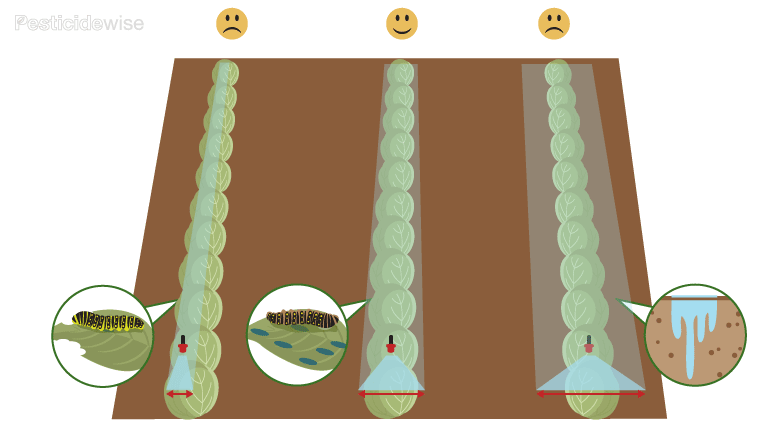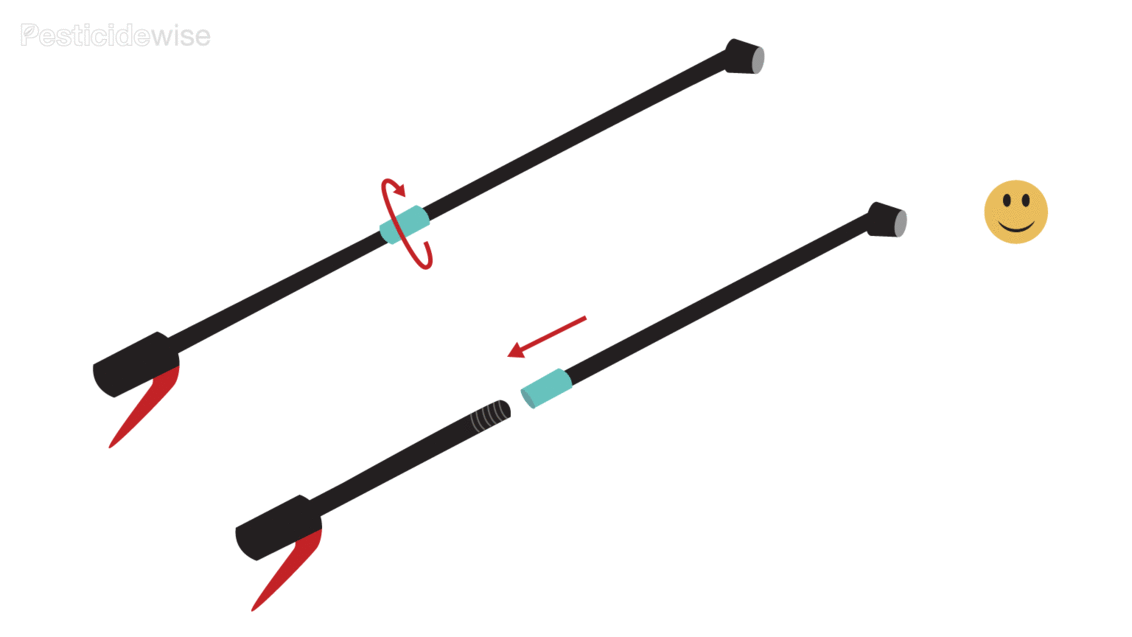Which spraying technique should I use?
Will you be spraying shorter or taller plants? Are your plants growing in rows or beds or do they cover an entire plot? Shall you be directing your spray downwards, laterally or upwards? Or are you simply spot spraying a few plants?
We explain the basics of how to knapsack spray so that you can choose the right technique for your current spraying task.
Downwards
add
remove
Use this spraying technique to spray crops, under 50 cm tall, for example: young tomato plants; cotton; sorghum; potatoes; sweet potatoes; rice; maize; wheat; barley; oats; soybeans; cassava; and sugar beet.
When spraying downwards, pull the sleeves of your coverall or shirt over the outside of your gloves. This will help to avoid spray mix getting inside your gloves and onto your hands.
Basics of spraying downwards
This spraying technique can be used to broadcast spray or direct pesticides over a crop row or between crop rows.
- Move forward at the constant speed that you used to calibrate your knapsack sprayer.
- Hold the nozzle steady and at the right height.
Allow your nozzle to do its work to apply the pesticide dose and spray mix/water volume in the swath and drop size needed. Do not swing the nozzle from side to side.
In more detail
Place short canes at the edges of your spray area at the mid-point of each swath. Use the canes to mark the nozzle route and guide your spraying path.
Broadcast spraying downwards
Spraying rows downwards
Inter-row and over-row spraying herbicides

Many pesticides control the pest through the leaf, without spray drops contacting the pest. The pesticide can move through the leaf and across the leaf to other leaves. This means that you may be able to use larger drops which are less likely to drift, reducing the risk of exposure both to you and the environment. Make sure that you spray the same width as the one used when you calibrated your knapsack sprayer so that you apply the right pesticide dose.
Check if your product can be applied as a ‘Medium’ drop size spray as these are safer to use and may better control the pest than the small ‘Fine’ ones that easily drift.
Laterally
add
remove
Use this spraying technique to spray crops up to 2 m high, for example: coffee; vines; cotton; tomatoes; maize; sorghum; sugar cane; bananas; oranges and apples.
Tuck your gloves inside your sleeve when spraying laterally to prevent spray running down the inside of your gloves. It is better practice to seal the join between glove and sleeve with tape.
Many bushes, vines and small trees up to 2 meters high are grown in rows. If you are using a knapsack sprayer to apply insecticides and fungicides, then you will have to spray both sides of the row.
Upwards
add
remove
Use this spraying technique to spray tall crops 2 m high or higher, for example: tall tomatoes; apples; oranges; bananas and dates.
When spraying pesticide upwards, you greatly increase the risk of contaminating yourself. Make sure that you are wearing the right PPE. Wear your gloves outside of your sleeve to prevent spray drops rolling down your hands and underneath your sleeve. Better practice is to seal the join between glove and sleeve.
Basics of spraying upwards
Spraying pesticides safely when you have to project the spray upwards is a challenge; drops of spray may fall back down over you or clouds of fine spray drops may drift downwind. Follow the advice on your pesticide label carefully on:
- how to reduce the risk of drift
- the PPE that you should use.
If you are spraying bushes or trees with dense, waxy, overlapping leaves, you may need to:
- start at the bottom of the canopy and
- direct the pesticide spray up and into the foliage so that the drops reach under the leaves.

For taller crops use an extension lance and angle the lance towards the crop. This will mean that you can:
- stand further back from the crop so that falling drops are more likely to miss you
- project the pesticide spray laterally (across) or downwards rather than upwards for most of the time: the less you project the spray directly upwards, the lower the chance that drops will fall back down.
Spraying tall row crops
Spraying larger bushes or trees in narrow sections
Spraying larger bushes or trees in wider sections
Remember, if you are using a nozzle with an even spread of spray drops across the swath, spray the swaths side-by-side with no gaps. If you are using a nozzle with a tapered swath, overlap the swaths as directed by the nozzle chart.